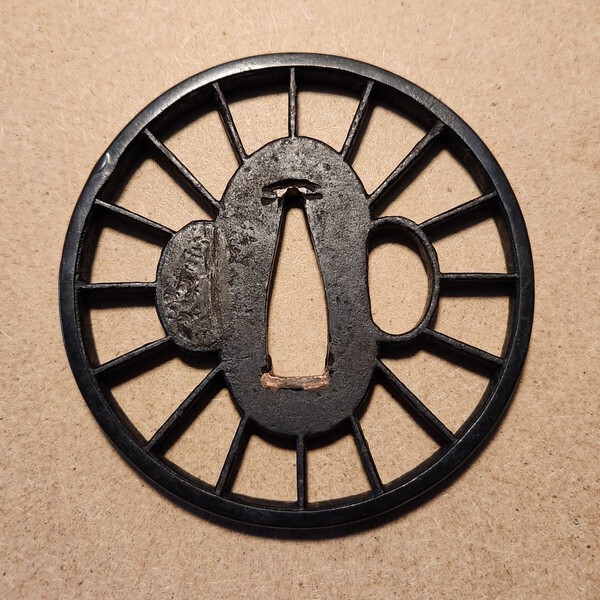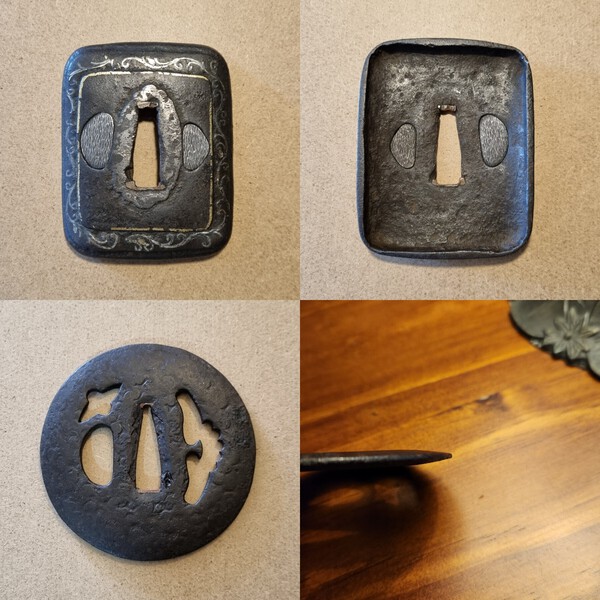-
Posts
634 -
Joined
-
Last visited
-
Days Won
3
Content Type
Profiles
Forums
Events
Store
Downloads
Gallery
Everything posted by Steves87
-
I am doubting the external finish is soft, but instead,very hard and brittle.... as per the info in the second half of the gpt image I shared. The Tsuba example I gave earlier in the thread is like this, some flaked off years ago and it was way harder than the iron interior, to the point that it didnt indent like iron should, but just "snapped"... i wish I had of put a magnet on it back then. Also, as per that second gpt part, it does make mention of coatings causing an encasement... take the finish look that it mentions with a grain of salt though.
-
Dan, for sure you should explore this... but do not lose sight of the knowledge that fires were very common in Edo Japan... you will need to prove that this was done purposefully (which I personally do not believe) as opposed to "accidently" caught in fire incidents (which I do believe is the case)
-
In high school many years ago we learnt about re-heating sand-iron and how it forms a shell... i forget the context of why we learnt this, and I don't care enough today to look into it further (happy new year by the way!) But a quick gpt brings up this: Click for clearer image. So it could be this too...
-
Dan, I'm not sure if this has been mentioned yet, but if you can find more cast Tsuba in museum collections and cross reference them with: donor life span, donation date, and date donor likely acquired them (by known expeditions).... you may get closer to an edo period 'confirmed' casting. There are a lot of museum collections that hold Tsuba acquired by westerners pre-1900... the major museums will likely have larger collections and better records, but there will be a ton more smaller museums which are more likely to hold cast Tsuba. Might be a wild goose chase, but you might also discover a cast Tsuba that was acquired during an expedition shortly after the mid 1880's, that eventually ended up as a museum donation.
-
I have this one with a Shakudo Fukerin... I notice there are a few others with the flat mimi in the thread... Iam wondering if a flat mimi makes the theme a Buddhist wheel, or we can still say it is Chrysanthemum?
-
I didn't say you were stupid... if you assume it was made in the Edo period though, then yes, yes I did.
-
Dan, the problem is that we knew the Tsuba was cast, we knew the theory of adverse effects, we tested the adverse affects theory and proved it... but we have no idea when the Tsuba was made... I thought the whole aim is to prove cast Tsuba were made in the Edo period? We have no idea when this Tsuba was made, and it is quite literally stupid to assume it was made in the Edo period. This test does not contribute to that discussion (cast Tsuba made in the Edo) other than reinforcing a call for further testing... which we knew all along at the beginning of the thread. P.s. I can see a cast sekigane, and the owner can in hand too
-
No, Dan, we knew the Tsuba was cast because of the cast top sekigane... that is why our bro did the test
-
Good experiment! You have definitely proved that the (mostly known) theory of tagane ato being added, will crack a cast Tsuba. However, we don't know when this Tsuba was made.... which I believe is the whole point of this thread. Is there a confirmed date for this Tsuba? I know it "looks old" but that doesn't mean it wasn't made in 1911. My father inlaw still has cast farm machinery components (used in orchard grading conveyors) made just after WW1 which look to have basically the same patina. Testing for the age of this Tsuba is the only way to prove anything for this thread... until then, we are basically still were we were on page 1. We know there are cast Tsuba, some will definitely be antiques in their own right now that we are almost in 2025... but were they made prior to the invasion of westerners, or were they made as a way of making money and producing them fast to keep up with western tourist demand? Or did the kettle makers whip a few out here and there... I would have, but different times, different cultures....
-
You don't have to believe me, but is more likely to be boiled linseed oil. It looks just like the finish on your Tsuba, and in the old days was done all the time, even on Tsuba. Do a google search of "boiled linseed oil on metal" plenty of results. There are even some threads on nmb which back this up... a user named Guido can confirm this... haven't seen him on here for a while though.
-
Not to worry, usually these ai are not good for 'scholarly' information, but they are extremely useful for conversions (e.g. language, characters, mathmatical) and program instruction, like learning the more complex features of software programs (think Excel settings and formulas). They can also be used for theme discovery (if you are cautious and properly describe the question). For example: "what is the theme of an edo period tsuba that depicts a rabbit, moon, and reeds in the context of Joly's Japanese mythology?" It may not be 100% accurate, but it will be close, and it will definitely contain clues for further research. Please experiment with it on information you know is correct, and you will very quickly see how much you can trust it for finding new leads. Part of the answer to the exact question asked is: 1. Rabbit and the Moon: In Japanese folklore, the rabbit is often associated with the moon, where it is believed to reside, endlessly pounding mochi (rice cakes). This imagery stems from the legend of the Moon Rabbit, a tale deeply rooted in Buddhist and Chinese traditions, emphasizing themes of selflessness and the cyclical nature of life.
-
-
How certain are you that it is varnish? Quite a while back there was a practice that used a linseed/terps mix... this ended up with a similar shiny look. I have found it harder to remove than varnish, to the point of having to horn scrape it off.
-
Very nice... apologies i cannot really answer what you are after, but I can provide an example which has very similar tendril inlay, similarly 'lined' tagane ato (if that is what it is), and potentially made of the same material (in different states of patina). I must also say, the nanako on your example is quite interesting the way it allows for the inome... and then kind of forms a namban-esque seppa dai shape.... pretty cool
-
Also, have a look at the other thread by Peter (BIG) for traditional inlay... although not Tsuba examples, these videos show the application of coverings post tannin process. https://www.militaria.co.za/nmb/topic/50876-traditional-inlays/#comment-530222
-
The kuchi-beni of Tanaka school has always given me a bit of a cliff-hanger feeling (although I Iove it)... it feels like it is almost at the point of 'friction not being enough'. I really love how the sekigane is part of the decoration. Apologies, just my .02c
-
Dan, I can promise you that Thomas and Manuel are correct. It is an applied finish (not metalic) that has been burnt (or 'cooked') unintentionally onto the metal plate. When the metal starts to corrode (below), it pushes the accidentally baked/cooked finish off the corroding metal plate. I admire your quest for cast Tsuba, but this particular thread will not add to the supporting evidence, if this is where you were heading (maybe you were not?) The base metal of the Tsuba in your original post has been cleaned or stabilised.... and with a mix of light/photo settings/conditions, makes it appear different to those subsequent provided images At the bottom this page is some other images of the same guard with different lighting https://rollingbrook...copy-of-project-08-5
-
Beat me to it Dale! Nice work as usual!
-
The rice theory is interesting, i never would have considered that, and now that you mention it, I can see what you are saying. I initially saw the dragon wrapped around a "bent" ken (bent for the design in accommodating the Tsuba shape). The picture below is my example of the ken (although a modern replica supposedly based on a historic original). The dragon is either swallowing it, or in my opinion, spewing it out... as history loves a good mythically produced sword.
-
Futatsu means two (like, two lobes), in what context im not entirely sure though... and admittedly, i got it from Sesko's sword encyclopaedia in the mokko section.
-
Also nown as futatsu-mokko-gata. Very nice guard by the way, congratulations!
-
There is actually three types Dan, named Wangata (bowl), Goishi-gata (convex both sides), and Hoiteibara (concave both sides). Here are some collages of 4 guards that i have in my collection. (Also on my PD website posted earlier this month, or late last that mentions these names).
-
Noted, I'll be on the look-out... I can't imagine they could sell it easily here though... between me and Dale scouring the very small local market, it would be hard for anything to slip through. I had a Namban guard go missing earlier in the year (West Aus), I paid through ebay with PayPal so I was fully refunded... but I suspect that the seller actually sent it to the wrong address.
-
Thank you Peter! The analytics do tell me if the visits originated from the forum, but I am quite interested in seeing the statistics between mobile device and desktop visits. As well as this data, I am interested in which countries the views originate from, I get the analytics from instagram too, and it appears most of my views are from Iranian cities, which i would have never thought. The US visits mostly originate from New York specifically. I am interested to see this in comparison with the website analytics. Of course, I do wonder how much of this is thrown off by vpn's.

















